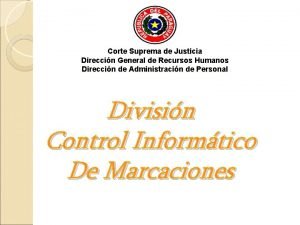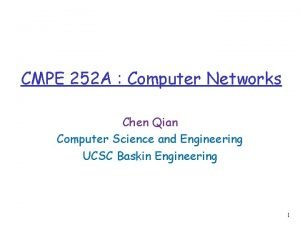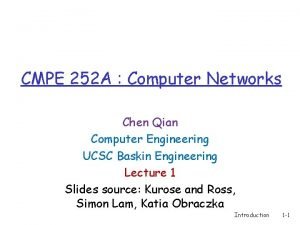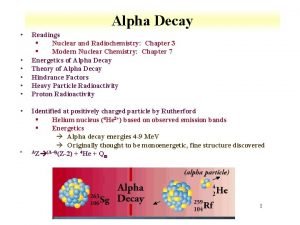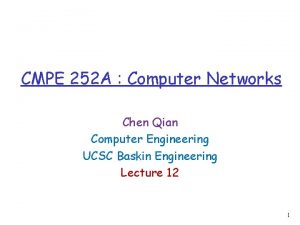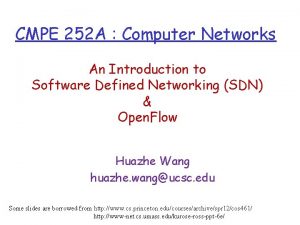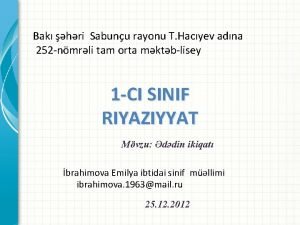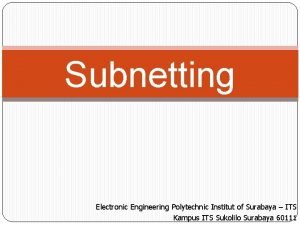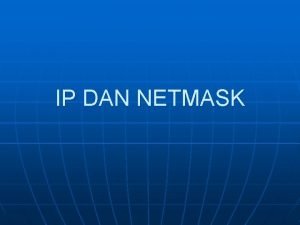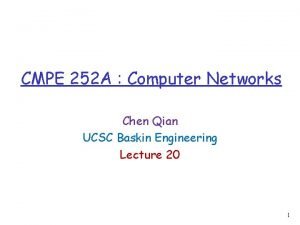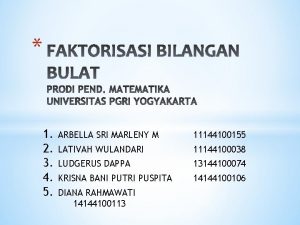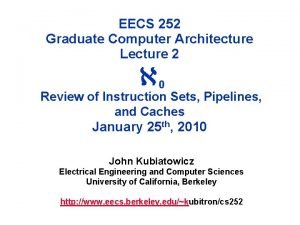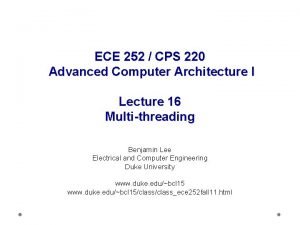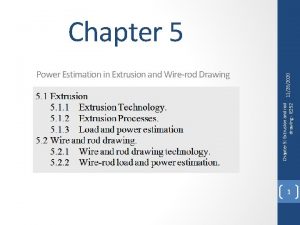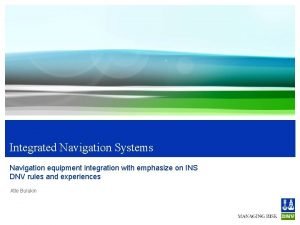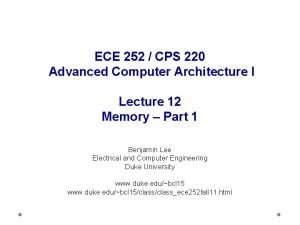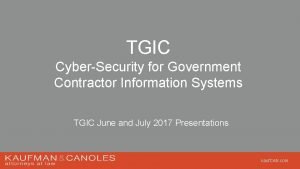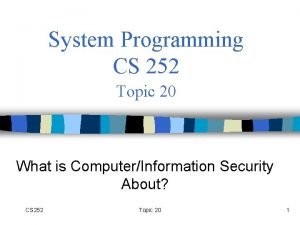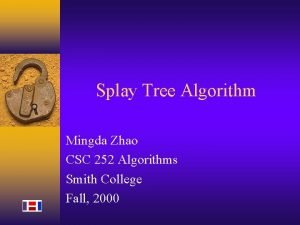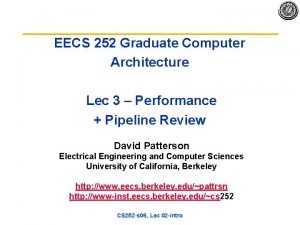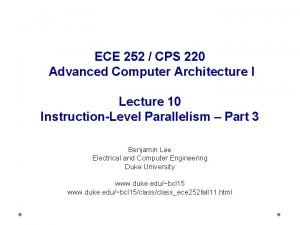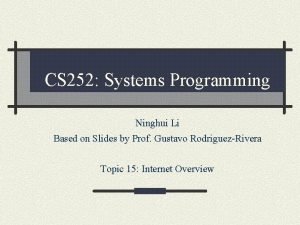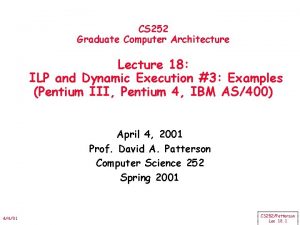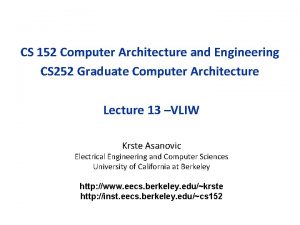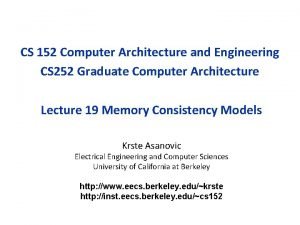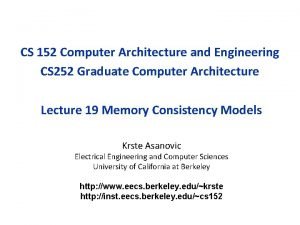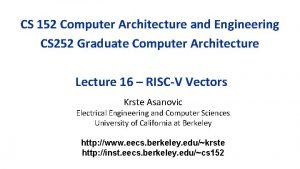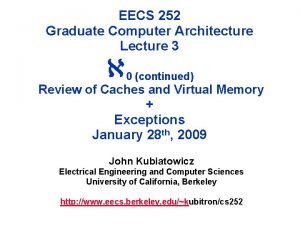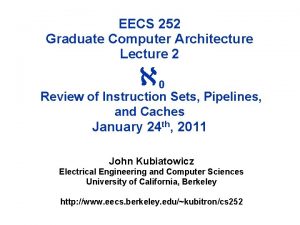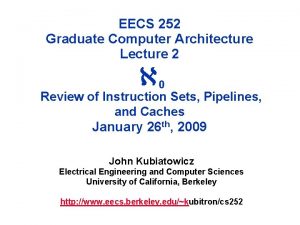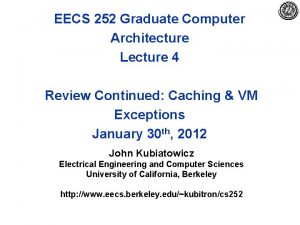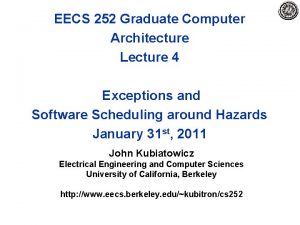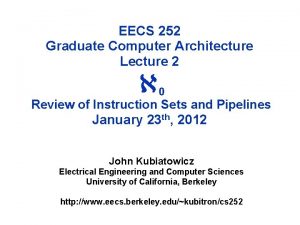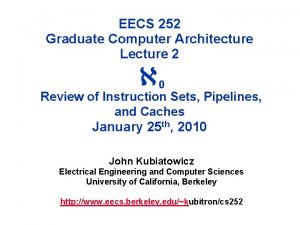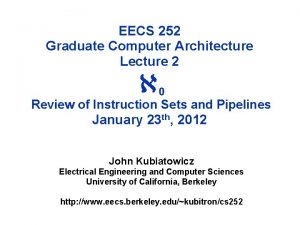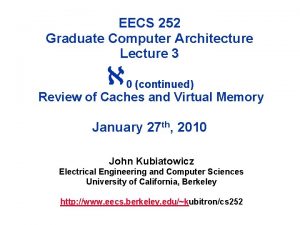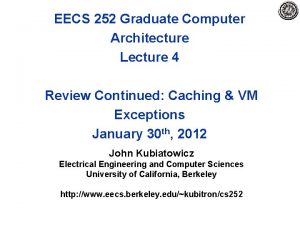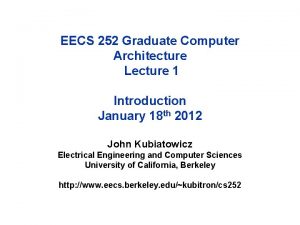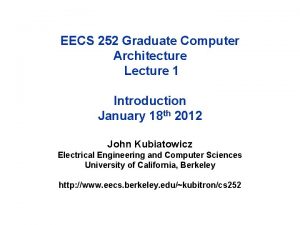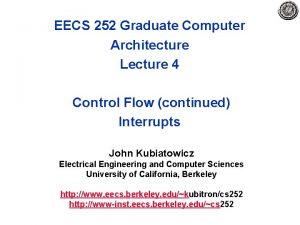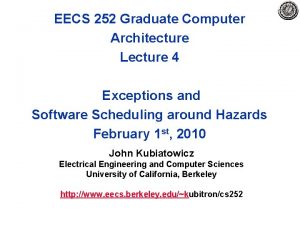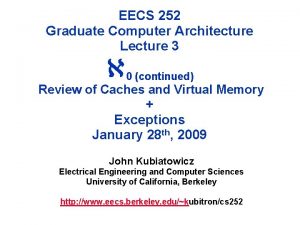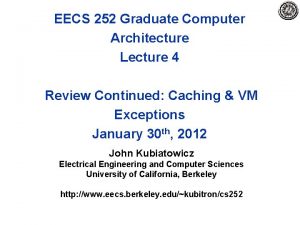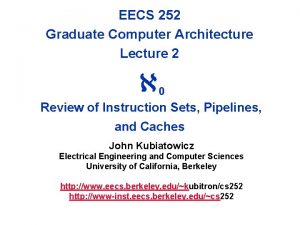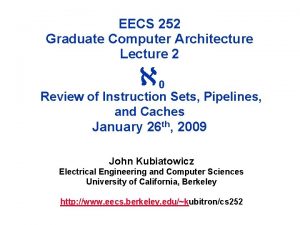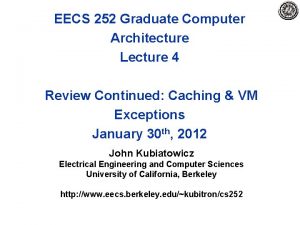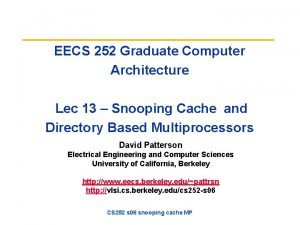EECS 252 Graduate Computer Architecture Lecture 3 0














































- Slides: 46

EECS 252 Graduate Computer Architecture Lecture 3 0 (continued) Review of Caches and Virtual Memory January 26 th, 2011 John Kubiatowicz Electrical Engineering and Computer Sciences University of California, Berkeley http: //www. eecs. berkeley. edu/~kubitron/cs 252

Review: Control and Pipelining • Control VIA State Machines and Microprogramming • Just overlap tasks; easy if tasks are independent • Speed Up Pipeline Depth; if ideal CPI is 1, then: Assumption is that each unpipelined instruction takes approximately Pipeline Depth cycles • Hazards limit performance on computers: – Structural: need more HW resources – Data (RAW, WAR, WAW): need forwarding, compiler scheduling – Control: delayed branch, prediction • Exceptions, Interrupts add complexity 1/27/2010 CS 252 -S 10, Lecture 03 2

Review: 5 Steps of MIPS Datapath Execute Addr. Calc Instr. Decode Reg. Fetch Next SEQ PC Adder 4 Zero? RS 1 RD RD RD MUX Sign Extend MEM/WB Data Memory EX/MEM ALU MUX ID/EX Imm Reg File IF/ID Memory Address RS 2 Write Back MUX Next PC Memory Access WB Data Instruction Fetch • Data stationary control 1/24/2011 – local decode for each instruction phase / pipeline stage CS 252 -S 11, Lecture 02 3

Branch Stall Impact • If CPI = 1, 30% branch, Stall 3 cycles => new CPI = 1. 9! • Two part solution: – Determine branch taken or not sooner, AND – Compute taken branch address earlier • MIPS branch tests if register = 0 or 0 • MIPS Solution: – Move Zero test to ID/RF stage – Adder to calculate new PC in ID/RF stage – 1 clock cycle penalty for branch versus 3 1/24/2011 CS 252 -S 11, Lecture 02 4

Pipelined MIPS Datapath Figure A. 24, page A-38 Instruction Fetch Memory Access Write Back Adder MUX Next SEQ PC Next PC Zero? RS 1 RD RD RD MUX Sign Extend MEM/WB Data Memory EX/MEM ALU MUX Imm ID/EX Reg File IF/ID Memory Address RS 2 WB Data 4 Execute Addr. Calc Instr. Decode Reg. Fetch • Interplay of instruction set design and cycle time. 1/24/2011 CS 252 -S 11, Lecture 02 5

Four Branch Hazard Alternatives #1: Stall until branch direction is clear #2: Predict Branch Not Taken – – – Execute successor instructions in sequence “Squash” instructions in pipeline if branch actually taken Advantage of late pipeline state update 47% MIPS branches not taken on average PC+4 already calculated, so use it to get next instruction #3: Predict Branch Taken – 53% MIPS branches taken on average – But haven’t calculated branch target address in MIPS » MIPS still incurs 1 cycle branch penalty » Other machines: branch target known before outcome 1/24/2011 CS 252 -S 11, Lecture 02 6

Four Branch Hazard Alternatives #4: Delayed Branch – Define branch to take place AFTER a following instruction branch instruction sequential successor 1 sequential successor 2. . . . sequential successorn branch target if taken Branch delay of length n – 1 slot delay allows proper decision and branch target address in 5 stage pipeline – MIPS uses this 1/24/2011 CS 252 -S 11, Lecture 02 7

Scheduling Branch Delay Slots A. From before branch add $1, $2, $3 if $2=0 then delay slot becomes B. From branch target sub $4, $5, $6 add $1, $2, $3 if $1=0 then delay slot becomes if $2=0 then add $1, $2, $3 if $1=0 then sub $4, $5, $6 C. From fall through add $1, $2, $3 if $1=0 then delay slot sub $4, $5, $6 becomes add $1, $2, $3 if $1=0 then sub $4, $5, $6 • A is the best choice, fills delay slot & reduces instruction count (IC) • In B, the sub instruction may need to be copied, increasing IC • In B and C, must be okay to execute sub when branch fails 1/24/2011 CS 252 -S 11, Lecture 02 8

Delayed Branch • Compiler effectiveness for single branch delay slot: – Fills about 60% of branch delay slots – About 80% of instructions executed in branch delay slots useful in computation – About 50% (60% x 80%) of slots usefully filled • Delayed Branch downside: As processor go to deeper pipelines and multiple issue, the branch delay grows and need more than one delay slot – Delayed branching has lost popularity compared to more expensive but more flexible dynamic approaches – Growth in available transistors has made dynamic approaches relatively cheaper 1/24/2011 CS 252 -S 11, Lecture 02 9

Memory Hierarchy Review 1/27/2010 CS 252 -S 10, Lecture 03 10

Since 1980, CPU has outpaced DRAM. . . Performance (1/latency) 1000 CPU 100 CPU 60% per yr 2 X in 1. 5 yrs Gap grew 50% per year DRAM 9% per yr DRAM 2 X in 10 yrs 10 0 198 0 199 200 0 Year • How do architects address this gap? 1/27/2010 – Put small, fast “cache” memories between CPU and DRAM. – Create a “memory hierarchy” CS 252 -S 10, Lecture 03 11

Memory Hierarchy • Take advantage of the principle of locality to: – Present as much memory as in the cheapest technology – Provide access at speed offered by the fastest technology Processor Control 1 s Size (bytes): 100 s 1/27/2010 On-Chip Cache Speed (ns): Registers Datapath Second Level Cache (SRAM) Main Memory (DRAM/ FLASH/ PCM) 10 s-100 s Ks-Ms Ms CS 252 -S 10, Lecture 03 Secondary Storage (Disk/ FLASH/ PCM) Tertiary Storage (Tape/ Cloud Storage) 10, 000 s 10, 000, 000 s (10 s ms) (10 s sec) Gs Ts 12

The Principle of Locality • The Principle of Locality: – Program access a relatively small portion of the address space at any instant of time. • Two Different Types of Locality: – Temporal Locality (Locality in Time): If an item is referenced, it will tend to be referenced again soon (e. g. , loops, reuse) – Spatial Locality (Locality in Space): If an item is referenced, items whose addresses are close by tend to be referenced soon (e. g. , straightline code, array access) • Last 15 years, HW relied on locality for speed 1/27/2010 CS 252 -S 10, Lecture 03 13

Memory Address (one dot per access) Programs with locality cache well. . . Bad locality behavior Temporal Locality Spatial Locality Time 1/27/2010 Donald J. Hatfield, Jeanette Gerald: Program Restructuring for Virtual Memory. IBM Systems CS 252 -S 10, Lecture 03 168 -192 (1971) Journal 10(3): 14

Memory Hierarchy: Apple i. Mac G 5 Managed by compiler Managed by hardware Managed by OS, hardware, application 07 Reg L 1 Inst L 1 Data L 2 DRAM Disk Size 1 K 64 K 32 K 512 K 256 M 80 G 1, 0. 6 ns 3, 1. 9 ns 11, 6. 9 ns 88, 55 ns 107, 12 ms Latency Cycles, Time i. Mac G 5 1. 6 GHz Goal: Illusion of large, fast, cheap memory Let programs address a memory space that scales to the disk size, at a speed that is usually as fast as register access 1/27/2010 CS 252 -S 10, Lecture 03 15

i. Mac’s Power. PC 970: All caches on-chip L 1 (64 K Instruction) Registers 512 K L 2 (1 K) 1/27/2010 L 1 (32 KCS 252 -S 10, Data) Lecture 03 16

Administrivia • Paper readings: important for your graduate career • Remember: everything on web site: – HTTP: //www. cs. berkeley. edu/~kubitron/cs 252 • Web. Site signup – Make sure to signup for the class if you haven’t yet • Don’t forget the ISCA retrospective 1/27/2010 CS 252 -S 10, Lecture 03 17

Memory Hierarchy: Terminology • Hit: data appears in some block in the upper level (example: Block X) – Hit Rate: the fraction of memory access found in the upper level – Hit Time: Time to access the upper level which consists of RAM access time + Time to determine hit/miss • Miss: data needs to be retrieve from a block in the lower level (Block Y) – Miss Rate = 1 - (Hit Rate) – Miss Penalty: Time to replace a block in the upper level + Time to deliver the block the processor • Hit Time << Miss Penalty (500 instructions on 21264!) To Processor Upper Level Memory Lower Level Memory Blk X From Processor 1/27/2010 Blk Y CS 252 -S 10, Lecture 03 18

4 Questions for Memory Hierarchy • Q 1: Where can a block be placed in the upper level? (Block placement) • Q 2: How is a block found if it is in the upper level? (Block identification) • Q 3: Which block should be replaced on a miss? (Block replacement) • Q 4: What happens on a write? (Write strategy) 1/27/2010 CS 252 -S 10, Lecture 03 19

Q 1: Where can a block be placed in the upper level? • Block 12 placed in 8 block cache: – Fully associative, direct mapped, 2 -way set associative – S. A. Mapping = Block Number Modulo Number Sets Full Mapped Direct Mapped (12 mod 8) = 4 2 -Way Assoc (12 mod 4) = 0 01234567 Cache 111112222233 0123456789012345678901 Memory 1/27/2010 CS 252 -S 10, Lecture 03 20

Sources of Cache Misses • Compulsory (cold start or process migration, first reference): first access to a block – “Cold” fact of life: not a whole lot you can do about it – Note: If you are going to run “billions” of instruction, Compulsory Misses are insignificant • Capacity: – Cache cannot contain all blocks access by the program – Solution: increase cache size • Conflict (collision): – Multiple memory locations mapped to the same cache location – Solution 1: increase cache size – Solution 2: increase associativity • Coherence (Invalidation): other process (e. g. , I/O) updates memory 1/27/2010 CS 252 -S 10, Lecture 03 21

Q 2: How is a block found if it is in the upper level? Block Address Index Tag Block offset Select Data Select • Index Used to Lookup Candidates in Cache – Index identifies the set • Tag used to identify actual copy – If no candidates match, then declare cache miss • Block is minimum quantum of caching – Data select field used to select data within block – Many caching applications don’t have data select field 1/27/2010 CS 252 -S 10, Lecture 03 22

Block Size and Spatial Locality Block is unit of transfer between the cache and memory Tag Split CPU address Word 0 Word 1 Word 2 Word 3 block address 4 word block, b=2 offsetb b bits 32 -b bits 2 b = block size a. k. a line size (in bytes) Larger block size has distinct hardware advantages • less tag overhead • exploit fast burst transfers from DRAM • exploit fast burst transfers over wide busses What are the disadvantages of increasing block size? Fewer blocks => more conflicts. Can waste bandwidth. 1/27/2010 CS 252 -S 10, Lecture 03 23

Review: Direct Mapped Cache • Direct Mapped 2 N byte cache: – The uppermost (32 - N) bits are always the Cache Tag – The lowest M bits are the Byte Select (Block Size = 2 M) • Example: 1 KB Direct Mapped Cache with 32 B Blocks – Index chooses potential block – Tag checked to verify block – Byte select chooses byte within block 31 Cache Tag Ex: 0 x 50 Cache Tag 0 x 50 4 0 Byte Select Ex: 0 x 00 Cache Data Byte 31 Byte 0 0 Byte 63 Byte 32 1 2 : : Valid Bit 9 Cache Index Ex: 0 x 01 3 : : Byte 1023 1/27/2010 CS 252 -S 10, Lecture 03 : : Byte 992 31 24

Review: Set Associative Cache • N-way set associative: N entries per Cache Index – N direct mapped caches operates in parallel • Example: Two-way set associative cache – Cache Index selects a “set” from the cache – Two tags in the set are compared to input in parallel – Data is selected based on the tag result 31 Cache Tag 8 Cache Index 4 0 Byte Select Valid Cache Tag Cache Data Cache Block 0 Cache Tag Valid : : : Compare Sel 1 1 Mux 0 Sel 0 Compare OR 1/27/2010 Hit. CS 252 -S 10, Lecture 03 Block Cache 25

Review: Fully Associative Cache • Fully Associative: Every block can hold any line – Address does not include a cache index – Compare Cache Tags of all Cache Entries in Parallel • Example: Block Size=32 B blocks – We need N 27 -bit comparators – Still have byte select to choose from within block 31 4 Cache Tag (27 bits long) Cache Tag Byte Select Ex: 0 x 01 Cache Data Valid Bit Byte 31 Byte 0 Byte 63 Byte 32 : : = 0 = = 1/27/2010 : CS 252 -S 10, Lecture 03 : : 26

Q 3: Which block should be replaced on a miss? • Easy for Direct Mapped • Set Associative or Fully Associative: – LRU (Least Recently Used): Appealing, but hard to implement for high associativity – Random: Easy, but – how well does it work? Assoc: 1/27/2010 2 -way 4 -way 8 -way Size LRU Ran 16 K 5. 2% 5. 7% 4. 7% 5. 3% 4. 4% 5. 0% 64 K 1. 9% 2. 0% 1. 5% 1. 7% 1. 4% 1. 5% 256 K 1. 15% 1. 17% 1. 13% 1. 12% CS 252 -S 10, Lecture 03 27

Q 4: What happens on a write? Write-Through Policy 1/27/2010 Data written to cache block Write-Back Write data only to the cache also written to lowerlevel memory Update lower level when a block falls out of the cache Debug Easy Hard Do read misses produce writes? No Yes Do repeated writes make it to lower level? Yes No Additional option -- let writes to an un-cached address allocate a new cache line (“write-allocate”). CS 252 -S 10, Lecture 03 28

Write Buffers for Write-Through Caches Cache Processor Lower Level Memory Write Buffer Holds data awaiting write-through to lower level memory Q. Why a write buffer ? A. So CPU doesn’t stall Q. Why a buffer, why not just one register ? A. Bursts of writes are common. Q. Are Read After Write A. Yes! Drain buffer before (RAW) hazards an issue next read, or check write for write buffer? buffers for match on reads 1/27/2010 CS 252 -S 10, Lecture 03 29

5 Basic Cache Optimizations • 1. 2. 3. Reducing Miss Rate Larger Block size (compulsory misses) Larger Cache size (capacity misses) Higher Associativity (conflict misses) • Reducing Miss Penalty 4. Multilevel Caches • Reducing hit time 5. Giving Reads Priority over Writes • 1/27/2010 E. g. , Read complete before earlier writes in write buffer CS 252 -S 10, Lecture 03 30

RISC: The integrated systems view (Discussion of Papers) • “The Case for the Reduced Instruction Set Computer” – Dave Patterson and David Ditzel • “Comments on ‘The Case for the Reduced Instruction Set Computer’” – Doug Clark and William Strecker • “"Retrospective on High-Level Computer Architecture" – David Ditzel and David Patterson In-class discussion of these papers 1/27/2010 CS 252 -S 10, Lecture 03 31

What is virtual memory? Virtual Address Space Physical Address Space Virtual Address 10 offset V page no. Page Table Base Reg index into page table Page Table V Access Rights PA table located in physical P page no. memory offset 10 Physical Address • Virtual memory => treat memory as a cache for the disk • Terminology: blocks in this cache are called “Pages” – Typical size of a page: 1 K — 8 K • Page table maps virtual page numbers to physical frames – “PTE” = Page Table Entry 1/27/2010 CS 252 -S 10, Lecture 03 32

What is in a Page Table Entry (PTE)? • What is in a Page Table Entry (or PTE)? – Pointer to next-level page table or to actual page – Permission bits: valid, read-only, read-write, write-only • Example: Intel x 86 architecture PTE: – Address same format previous slide (10, 12 -bit offset) – Intermediate page tables called “Directories” 1/27/2010 PWT P: W: U: PWT: PCD: A: D: L: Free 0 L D A UW P (OS) 11 -9 8 7 6 5 4 3 2 1 0 PCD Page Frame Number (Physical Page Number) 31 -12 Present (same as “valid” bit in other architectures) Writeable User accessible Page write transparent: external cache write-through Page cache disabled (page cannot be cached) Accessed: page has been accessed recently Dirty (PTE only): page has been modified recently L=1 4 MB page (directory only). Bottom 22 bits of virtual address serve as offset CS 252 -S 10, Lecture 03 33

Three Advantages of Virtual Memory • Translation: – Program can be given consistent view of memory, even though physical memory is scrambled – Makes multithreading reasonable (now used a lot!) – Only the most important part of program (“Working Set”) must be in physical memory. – Contiguous structures (like stacks) use only as much physical memory as necessary yet still grow later. • Protection: – Different threads (or processes) protected from each other. – Different pages can be given special behavior » (Read Only, Invisible to user programs, etc). – Kernel data protected from User programs – Very important for protection from malicious programs • Sharing: – Can map same physical page to multiple users (“Shared memory”) 1/27/2010 CS 252 -S 10, Lecture 03 34

Large Address Space Support 10 bits Virtual Address: P 1 index P 2 index 12 bits Physical Address: Page # Offset 4 KB Page. Table. Ptr 4 bytes • Single-Level Page Table Large – 4 KB pages for a 32 -bit address 1 M entries – Each process needs own page table! • Multi-Level Page Table – Can allow sparseness of page table – Portions of table can be swapped to disk 1/27/2010 CS 252 -S 10, Lecture 03 4 bytes 35

Translation Look-Aside Buffers • Translation Look-Aside Buffers (TLB) – Cache on translations – Fully Associative, Set Associative, or Direct Mapped hit PA VA CPU Translation with a TLB miss Cache Main Memory hit Translation data • TLBs are: – Small – typically not more than 128 – 256 entries – Fully Associative 1/27/2010 CS 252 -S 10, Lecture 03 36

Caching Applied to Address Translation CPU Virtual Address TLB Cached? Yes No Translate (MMU) Physical Address e v t Sa sul Re Physical Memory Data Read or Write (untranslated) • Question is one of page locality: does it exist? – Instruction accesses spend a lot of time on the same page (since accesses sequential) – Stack accesses have definite locality of reference – Data accesses have less page locality, but still some… • Can we have a TLB hierarchy? 1/27/2010 – Sure: multiple levels at different sizes/speeds CS 252 -S 10, Lecture 03 37

What Actually Happens on a TLB Miss? • Hardware traversed page tables: – On TLB miss, hardware in MMU looks at current page table to fill TLB (may walk multiple levels) » If PTE valid, hardware fills TLB and processor never knows » If PTE marked as invalid, causes Page Fault, after which kernel decides what to do afterwards • Software traversed Page tables (like MIPS) – On TLB miss, processor receives TLB fault – Kernel traverses page table to find PTE » If PTE valid, fills TLB and returns from fault » If PTE marked as invalid, internally calls Page Fault handler • Most chip sets provide hardware traversal – Modern operating systems tend to have more TLB faults since they use translation for many things – Examples: » shared segments » user-level portions of an operating system 1/27/2010 CS 252 -S 10, Lecture 03 38

Clock Algorithm: Not Recently Used Set of all pages in Memory Single Clock Hand: Advances only on page fault! Check for pages not used recently Mark pages as not used recently • Clock Algorithm: – Approximate LRU (approx to MIN) – Replace an old page, not the oldest page Page Table dirty used 1 1 0 0 0 1 1 0 . . . • Details: – Hardware “use” bit per physical page: » Hardware sets use bit on each reference » If use bit isn’t set, means not referenced in a long time – On page fault: » Advance clock hand (not real time) » Check use bit: 1 used recently; clear and leave alone 0 selected candidate for replacement 1/27/2010 CS 252 -S 10, Lecture 03 39

Example: R 3000 pipeline MIPS R 3000 Pipeline Dcd/ Reg Inst Fetch TLB I-Cache RF ALU / E. A Memory Operation E. A. TLB Write Reg WB D-Cache TLB 64 entry, on-chip, fully associative, software TLB fault handler Virtual Address Space ASID 6 V. Page Number 20 Offset 12 0 xx User segment (caching based on PT/TLB entry) 100 Kernel physical space, cached 101 Kernel physical space, uncached 11 x Kernel virtual space Allows context switching among 64 user processes without TLB flush 1/27/2010 CS 252 -S 10, Lecture 03 40

Reducing translation time further • As described, TLB lookup is in serial with cache lookup: Virtual Address 10 offset V page no. TLB Lookup V Access Rights PA P page no. offset 10 Physical Address • Machines with TLBs go one step further: they overlap TLB lookup with cache access. – Works because offset available early 1/27/2010 CS 252 -S 10, Lecture 03 41

Overlapping TLB & Cache Access • Here is how this might work with a 4 K cache: 32 assoc lookup index TLB 10 2 disp 00 20 page # Hit/ Miss FN 4 K Cache = 1 K 4 bytes FN Data Hit/ Miss • What if cache size is increased to 8 KB? – Overlap not complete – Need to do something else. See CS 152/252 • Another option: Virtual Caches – Tags in cache are virtual addresses – Translation only happens on cache misses 1/27/2010 CS 252 -S 10, Lecture 03 42

Problems With Overlapped TLB Access • Overlapped access requires address bits used to index into cache do not change as result translation – This usually limits things to small caches, large page sizes, or high – n-way set associative caches if you want a large cache • Example: suppose everything the same except that the cache is increased to 8 K bytes instead of 4 K: 11 cache index 20 virt page # 2 00 12 disp This bit is changed by VA translation, but is needed for cache lookup Solutions: go to 8 K byte page sizes; go to 2 way set associative cache; or SW guarantee VA[13]=PA[13] 10 1/27/2010 1 K 4 4 CS 252 -S 10, Lecture 03 2 way set assoc cache 43

Summary #1/3: The Cache Design Space • Several interacting dimensions – – – Cache Size cache size block size associativity replacement policy write-through vs write-back write allocation Associativity • The optimal choice is a compromise – depends on access characteristics » workload » use (I-cache, D-cache, TLB) – depends on technology / cost • Simplicity often wins 1/27/2010 Block Size Bad Good CS 252 -S 10, Lecture 03 Factor A Less Factor B More 44

Summary #2/3: Caches • The Principle of Locality: – Program access a relatively small portion of the address space at any instant of time. » Temporal Locality: Locality in Time » Spatial Locality: Locality in Space • Three Major Categories of Cache Misses: – Compulsory Misses: sad facts of life. Example: cold start misses. – Capacity Misses: increase cache size – Conflict Misses: increase cache size and/or associativity. Nightmare Scenario: ping pong effect! • Write Policy: Write Through vs. Write Back • Today CPU time is a function of (ops, cache misses) vs. just f(ops): affects Compilers, Data structures, and Algorithms 1/27/2010 CS 252 -S 10, Lecture 03 45

Summary #3/3: TLB, Virtual Memory • Page tables map virtual address to physical address • TLBs are important for fast translation • TLB misses are significant in processor performance – funny times, as most systems can’t access all of 2 nd level cache without TLB misses! • Caches, TLBs, Virtual Memory all understood by examining how they deal with 4 questions: 1) Where can block be placed? 2) How is block found? 3) What block is replaced on miss? 4) How are writes handled? • Today VM allows many processes to share single memory without having to swap all processes to disk; today VM protection is more important than memory hierarchy benefits, but computers insecure • Prepare for debate + quiz on Wednesday 1/27/2010 CS 252 -S 10, Lecture 03 46
 Architecture lecture notes
Architecture lecture notes Microarchitecture vs isa
Microarchitecture vs isa 01:640:244 lecture notes - lecture 15: plat, idah, farad
01:640:244 lecture notes - lecture 15: plat, idah, farad Bus architecture in computer architecture
Bus architecture in computer architecture Computer architecture and computer organization difference
Computer architecture and computer organization difference Design of a basic computer
Design of a basic computer Acordada 961/15
Acordada 961/15 Cmpe 252
Cmpe 252 Chen qian ucsc
Chen qian ucsc Cf-252 decay scheme
Cf-252 decay scheme Simplified radical of 108
Simplified radical of 108 History observation palpation special tests
History observation palpation special tests Cmpe 252
Cmpe 252 Cmpe 252
Cmpe 252 4 en hexadecimal
4 en hexadecimal ədədin iki qatı
ədədin iki qatı 252 netmask
252 netmask 252 netmask
252 netmask 252 basics
252 basics Chen qian ucsc
Chen qian ucsc Fpb dari 198
Fpb dari 198 Cpi processor
Cpi processor Ece 252
Ece 252 Ie 252
Ie 252 Mcd
Mcd Msc.252(83)
Msc.252(83) Dfars 252
Dfars 252 Ece 252
Ece 252 Dfars 252 204 7012
Dfars 252 204 7012 Cs 252
Cs 252 Csc 252
Csc 252 Florida statute 252
Florida statute 252 252 lec
252 lec Cps 220
Cps 220 Purdue cs 252
Purdue cs 252 Cs 252
Cs 252 Cs 252
Cs 252 Cs 252
Cs 252 Cs 252
Cs 252 Cs 252
Cs 252 Cs 252
Cs 252 Cs 252
Cs 252 Lab=01 ust
Lab=01 ust Cmk 252/3
Cmk 252/3 Computer security 161 cryptocurrency lecture
Computer security 161 cryptocurrency lecture Computer aided drug design lecture notes
Computer aided drug design lecture notes Explain architecture business cycle
Explain architecture business cycle






